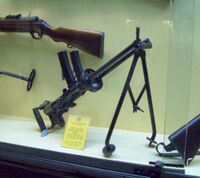Engineering:Villar Perosa aircraft submachine gun
| Villar Perosa | |
|---|---|
| Type | Submachine gun Aircraft machine gun |
| Place of origin | Italy |
| Service history | |
| Used by | See users |
| Wars | World War I |
| Production history | |
| Designed | 1914 |
| Specifications | |
| Mass | 6.5 kg (14 lb) |
| Length | 533 mm (21.0 in) |
| Barrel length | 320 mm (13 in) |
| Cartridge | 9mm Glisenti |
| Barrels | 2 side by side |
| Action | blowback |
| Rate of fire | 1200-1500 rounds/min per barrel, 2400-3000 total |
| Feed system | Box Magazine 25 rounds per gun |

The Pistola Mitragliatrice Villar Perosa M1915, official named FIAT Mod. 1915, was an Italian portable automatic firearm developed during World War I by the Officine di Villar Perosa.
Originally designed to be used by the second crew member/observer of military airplanes, it was later issued to ground troops. Between May and November 1916 a section was assigned to each infantry battalion of the Italian army and from May 1917 the number of sections was increased to 3 per battalion.
As it was designed to use 9mm pistol ammunition, it is said to be the first true submachine gun.[1] Due to its extremely high rate of fire, it was nicknamed Pernacchia (raspberry) by its operators.
Design
The Villar Perosa was designed as a portable double-barrel machine gun firing a 9mm round. It consisted of two independent coupled weapons, each with its own barrel, firing mechanism, and separate 25-round magazine.
Operational history
As it was originally designed to be operated from airplanes, it had a high rate of fire of over 1,500 rounds per minute. However, in practice the 9mm munition was not sufficiently powerful to shoot down aircraft, which had become ever more resistant over the course of the war, and in addition the range was inadequate, so it was eventually dismissed by the Corpo Aeronautico.
It was also used during World War I by the Italian Infantry, with a bipod and a gun shield (which proved to be uncomfortable in combat and was subsequently removed). Despite its high rate of fire, its atypical design, and its weight, it proved to be very effective at short range.[1] It was operated by Bersaglieri too, often mounted on bicycles.[2]
It was in particular appreciated as a squad weapon by the Arditi, the Royal Italian Army World War I shock troops, due to its high rate of fire and its weight (it was light for a machine gun), and went under various modifications: Lt. Col. Giuseppe Bassi personally designed a carrying system (consisting of a leather belt fixed to the handles that was later arranged behind the gunner's neck) and a 1.6 kg bipod and removed the gun shield (which weighed roughly 26 kg) to enhance Arditi performances in battle. In his idea, a section of 8 (later 16) VP machine guns had to support the attack of 20-30 Arditi armed with rifle, dagger and hand-grenades, giving an adequate suppressive fire and striking the enemy on a psychological level too. Every weapon was manned by 4 people: a shooter with a backpack or a shoulder ammo bag and 3 ammo carriers, who could take with them up to 5000 rounds.[3]
Some VP machine pistols were equipped with a wooden stock, though the firing mechanism remained unaltered and was not modified in the fashion of, for example, the OVP SMG or the MAB 18.[4]
Legacy
In 1918, Austria-Hungary created a copy of the VP, the Sturmpistole M.18, which featured a straight magazine rather than curved magazines.[5]
The mechanism of the VP was a sound design, and shortly after the end of the war was used as the basis of more practical weapons, such as the OVP submachine gun and the Beretta MAB-18.[4]
Users
 Italy[1]
Italy[1] Austria-Hungary: Captured examples
Austria-Hungary: Captured examples Germany: Captured examples
Germany: Captured examples United Kingdom: Trial purposes, chambered in .455 Webley Auto[6][7]
United Kingdom: Trial purposes, chambered in .455 Webley Auto[6][7]
See also
- Beretta M1918
- Gast gun
References
- ↑ 1.0 1.1 1.2 Nicolle, David (25 Mar 2003). The Italian Army of World War I. Men-at-Arms 387. Osprey Publishing. p. 33. ISBN 9781841763989. https://books.google.com/books?id=SZoeDAAAQBAJ&pg=PA33.
- ↑ "Machine Guns of WWI - SADJ Commemorates the 100th Anniversary of World War I". http://www.sadefensejournal.com/wp/machine-guns-of-wwi-sadj-commemorates-the-100th-anniversary-of-world-war-i/.
- ↑ Pirocchi, Angelo (2004). Italian Arditi - Elite Assault Troops 1917-1920. Osprey Publishing. pp. 31-32. ISBN 1841766860.
- ↑ 4.0 4.1 "Pistola Mitragliatrice Villar Perosa - FIAT M1915". http://www.maquetland.com/article-phototheque/6211-pistola-mitragliatrice-villar-perosa-fiat-m-1915.
- ↑ Landships II, http://www.landships.info/landships/weapon_articles.html?load=weapon_articles/Villar_Perosa.html
- ↑ "Villar Perosa". http://www.forgottenweapons.com/light-machine-guns/villar-perosa/.
- ↑ Anthony G. Williams (2012). Sub-Machine Gun: The Development of Sub-Machine Guns and their Ammunition from World War 1 to the Present Day. The Crowood Press UK. p. 260. ISBN 978-1847972934.
Bibliography
- George M. Chinn, The Machine Gun. History, Evolution, and Development of Manual, Automatic, and Airborne Repeating Weapons, Volume I.
- Philip Schreier, The World's First Sub-Gun. Guns & Ammo Surplus Firearms, September 2009.
External links
- YouTube video of the Villar Perosa SMG Firing
- Defence Configuration
- Replica Aircraft Configuration
- Villar Perosa 9mm MOD.15 SMG
- Modern Firearms
- M1915 Video
- YouTube animation showing mechanism of Villar Perosa mounted in Voisin 3 aircraft

